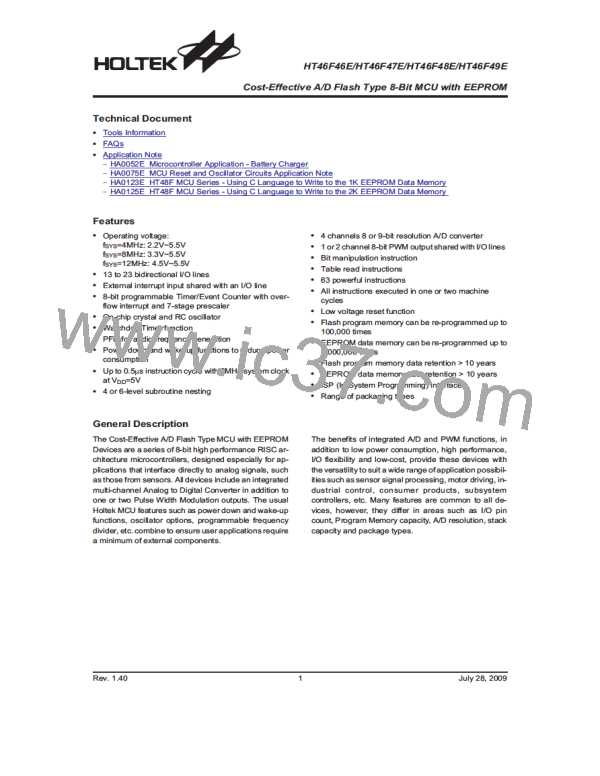HT46F46E/HT46F47E/HT46F48E/HT46F49E
Analog to Digital Converter
The need to interface to real world analog signals is a
common requirement for many electronic systems.
However, to properly process these signals by a
microcontroller, they must first be converted into digital
signals by A/D converters. By integrating the A/D con-
version electronic circuitry into the microcontroller, the
need for external components is reduced significantly
with the corresponding follow-on benefits of lower costs
and reduced component space requirements.
Converter Data Registers, note that only the high byte
register ADRH utilises its full 8-bit contents. The low
byte register utilises only 1 bit of its 8-bit contents as it
contains only the lowest bit of the 9-bit converted value.
In the following tables, D0~D8 are the A/D conversion
data result bits.
Bit Bit Bit Bit Bit Bit Bit Bit
Register
7
6
5
4
3
2
1
0
ADR
D7 D6 D5 D4 D3 D2 D1 D0
A/D Overview
A/D Data Register - HT46F46E
Each of the devices contains a 4-channel analog to digi-
tal converter which can directly interface to external an-
alog signals, such as that from sensors or other control
signals and convert these signals directly into either an
8-bit or 9-bit digital value.
Bit Bit Bit Bit Bit Bit Bit Bit
Register
7
6
5
4
3
2
1
0
ADRL
ADRH
D0
¾
¾
¾
¾
¾
¾
¾
Input
Conversion
Bits
D8 D7 D6 D5 D4 D3 D2 D1
Device
Input Pins
Channels
A/D Data Register - Other Devices
HT46F46E
HT46F47E
HT46F48E
HT46F49E
4
4
4
4
8
9
9
9
PB0~PB3
PB0~PB3
PB0~PB3
PB0~PB3
A/D Converter Control Register - ADCR
To control the function and operation of the A/D con-
verter, a control register known as ADCR is provided.
This 8-bit register defines functions such as the selec-
tion of which analog channel is connected to the internal
A/D converter, which pins are used as analog inputs and
which are used as normal I/Os as well as controlling the
start function and monitoring the A/D converter end of
conversion status.
The following diagram shows the overall internal struc-
ture of the A/D converter, together with its associated
registers.
A/D Converter Data Registers - ADR, ADRL, ADRH
One section of this register contains the bits
ACS2~ACS0 which define the channel number. As each
of the devices contains only one actual analog to digital
converter circuit, each of the individual 4 analog inputs
must be routed to the converter. It is the function of the
ACS2~ACS0 bits in the ADCR register to determine
which analog channel is actually connected to the inter-
nal A/D converter. Note that the ACS2 bit must always
be assigned a zero value.
For the HT46F46E device, which has an 8-bit A/D con-
verter, a single register, known as ADR, is used to store
the 8-bit analog to digital conversion value. For the re-
maining devices, which have a 9-bit A/D converter, two
registers are required, a high byte register, known as
ADRH, and a low byte register, known as ADRL. After
the conversion process takes place, these registers can
be directly read by the microcontroller to obtain the digit-
ised conversion value. For devices which use two A/D
C
l
o
c
k
D
i
v
i
d
e
R
a
t
i
o
A
D
C
S
o
u
r
c
e
¸
A
C
S
R
R
e
g
i
s
t
e
r
N
f
S
Y
S
V
D
D
A
/
D
r
e
f
e
r
e
n
c
e
v
o
l
t
a
g
e
P
P
P
P
B
B
B
B
0
1
2
3
/
/
/
/
A
A
A
A
N
N
N
N
0
1
2
3
A
D
R
A
D
C
o
r
A
/
D
D
a
t
a
R
L
e
g
i
s
t
e
r
s
A
D
R
A
D
R
H
A
D
C
R
P
C
R
0
~
P
A
C
D
R
C
2
S
0
~
S
A
T
D
A
C
E
R
S
O
T
2
C
B
R
e
g
i
s
t
e
r
S
t
a
r
t
B i
d
t
t
o
E
n
f
P
i
n
C
o
n
C
f
h
i
a
n
n
a
e
t
l
i
o
S
n
e
l
e
c
C
o
n
v
e
r
s
i
o
n
B
i
t
B
i
t
s
B
i
t
s
A/D Converter Structure
Rev. 1.40
38
July 28, 2009

 HOLTEK [ HOLTEK SEMICONDUCTOR INC ]
HOLTEK [ HOLTEK SEMICONDUCTOR INC ]